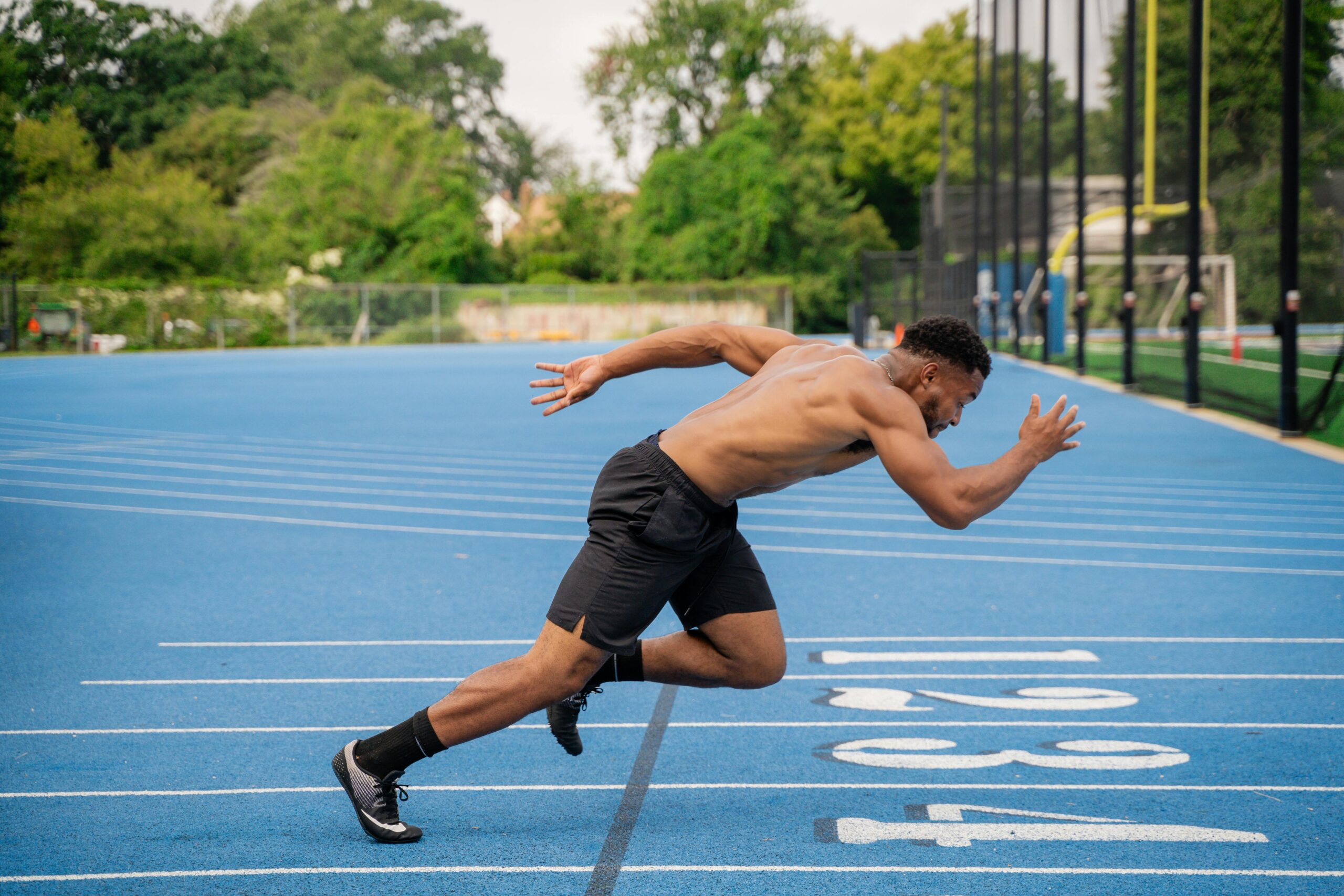When most beginners take up running, the focus is usually on building distance or improving pace. And while those are worthy goals, they often come at the expense of something just as important: our running form.
A good running form is the foundation of efficient, injury-free movement. It affects everything from how much energy you use to how fast you recover after a run. Proper posture, stride, and arm movement work together to reduce joint stress, improve breathing, and make your runs feel smoother and more controlled.
Unfortunately, one of the most common running mistakes beginners make is neglecting their form, leading to nagging pain, poor performance, or frustration later on.
This guide explains proper running form tips beginners should know and provides clear, actionable tips for fixing the most common issues.
Whether you are just starting out or want to correct bad habits, these tips will help you run more efficiently, reduce injury risk, and enjoy the miles ahead.
What Happens If You Have Poor Running Form?
Most beginners don’t realize how much their running form affects their progress until discomfort or injury creeps in. Here’s what can happen if you overlook your running form:
Energy inefficiency
When your form is off, your body works harder with every stride. Slouching, overstriding, or stiff arm movements reduce running economy, making you burn more energy for the same distance.
The result? You tire out faster and struggle to maintain a consistent pace.
Joint overuse and common injuries
Improper mechanics place extra strain on your joints, muscles, and tendons. Over time, this stress can lead to a range of common injuries.
Runner’s knee typically causes pain around the kneecap, while shin splints result in irritation and discomfort along the lower legs. IT band syndrome creates sharp pain on the outer knee or hip, and lower back or calf strain often stems from imbalances or poor body alignment during movement.
Slower progress and mental fatigue
Poor form does not just affect your body; it also impacts your mindset.
When runs feel harder than they should or pain sets in early, motivation can take a hit. And this leads to inconsistent training, slower progress, and sometimes even quitting altogether.
Posture: How Should You Hold Your Body While Running?
Your posture forms the foundation of your running form. If your body is misaligned, even slightly, it can throw off your stride, breathing, and energy efficiency.
Good posture helps you stay balanced, reduce tension, and maintain control, especially on longer runs.
Here are running form tips beginners should know:
Keep your head up and gaze forward.
Avoid the habit of looking down at your feet.
Keep your eyes focused 10 to 20 feet ahead of you to maintain balance and open up your airways. This simple chance also helps align your neck and spine naturally.
Relax your shoulders and keep your chest open.
Tense shoulders creep up toward your ears as you fatigue, and that tension drains energy.
Actively relax your shoulders and keep your chest lifted to encourage deep, rhythmic breathing.
Avoid leaning too far forward or backward.
A slight forward lean from the ankles (not the waist) is ideal, but avoid hunching or leaning back. Excessive title throws off your center of gravity, leading to joint strain or inefficient movement.
Engage your core for balance and control.
A strong, engaged core keeps your posture stable, especially when fatigue sets in.
It helps you absorb impact better, reduces wobble in your stride, and allows smoother transitions between strides.
How Should Your Stride and Foot Strike Look While Running?
Your stride and foot strike majorly affect how efficiently and safely you move. Many beginners don’t realize that how their feet hit the ground can support performance or lead to nagging pain and injuries. A few small adjustments can make a huge difference in comfort and endurance.
Here are running form tips beginners should know:
-
Don’t overstride
Overstriding happens when your foot lands too far in front of your body. This creates a braking effect that increases impact on your knees and hips. It also shows you down and wastes energy.
Aim for a stride that keeps your feet landing beneath your hips, not out ahead.
-
Aim for a midfoot strike under your center of mass
Landing on your midfoot (rather than your heel) allows for better shock absorption and smoother transitions. Ideally, your foot should make contact just under your center of gravity to reduce strain and promote forward motion.
-
Keep steps short and quick
Short, quick steps are more efficient than long, heavy strides.
A cadence of around 180 steps per minute is a good target for most runners. You don’t have to count every step, just think light and rhythmic rather than long and pounding.
-
Visual tip: “Run tall, land softly”
Imagine a string gently pulling you upward from the top of your head. Stay upright, relaxed, and light on your feet.
Running “tall” improves alignment, while “landing softly” reduces impact with each stride.
How Should You Use Your Arms and Upper Body While Running?
While running is primarily a lower-body movement, your arms and upper body play a critical role in balance, rhythm, and overall efficiency.
Poor upper-body mechanics can throw off your stride, waste energy, and lead to tension in the shoulders and neck. Dialing in your arm swing can help your legs move more freely and keep your form stable as you fatigue. Here are running form tips beginners should know:
Bend your arms at 90 degrees
Keep your elbows bent at a right angle and close to your sides. This position gives you leverage and allows a smooth, controlled swing without crossing your body’s midline.
Swing arms front-to-back, not across your chest
Avoid twisting or swinging your arms side-to-side, throwing off your balance, and wasting energy. Your arms should move front-to-back, brushing past your hips in a relaxed, controlled rhythm.
Keep your hands relaxed
Clenched fists create unnecessary tension that can travel up your arms to your shoulders. Imagine holding something delicate, like a potato chip or a loose sponge, in each hand. This keeps your upper body fluid and stress-free.
Let your arm rhythm guide your stride
When your arms move smoothly and rhythmically, your legs follow. Use your arms to help maintain tempo, especially when you are picking up the pace or tackling a hill.
A strong, steady arm drive makes running feel more powerful and controlled.
What Drills Can Improve Your Running Form?
Improving your running form isn’t just about knowing what good technique looks like. It’s about training your body to move that way naturally.
Drills help reinforce proper mechanics by building coordination, strength, and muscle memory. Even a few minutes of focused movement each week can make your stride smoother, stronger, and more efficient.
1. High knees
This classic drill helps with knee drive, cadence, and posture.
Stand tall and drive your knees toward your chest one at a time in quick succession while pumping your arms. Keep the motion light and controlled. Aim for 20 to 30 seconds per set.
2. A-skips and B-skips
These coordination drills mimic the running stride while reinforcing proper foot placement and arm-leg timing.
A-skips emphasize high knees and rhythm.
B-skips add a leg extension after the knee drive to build stride efficiency.
These are great warm-up drills or form-focused training tools.
3. Arm swing practice in front of a mirror
Stand tall, bend your arms at 90 degrees, and practice swinging them front to back, keeping elbows close and hands relaxed. Watching your form in a mirror helps you avoid common mistakes like crossing over your body or clenching your fists.
4. Posture resets and walking drills
Practice short posture resets during warm-ups:
- Stand stall
- Gaze forward
- Engage your core
- Take a few slow steps while focusing on alignment
Walking drills like exaggerated heel-to-toe strides can help with foot awareness and balance.
5. Core exercises for form control
Strong posture starts with a strong core.
Add planks, glute bridges, bird-dogs, and side planks to your weekly routine.
These build the stability you need to maintain form, especially on longer runs.
How Can You Check and Fix Your Running Form?
Understanding proper running mechanics is one thing; putting them into practice is another. Even experienced runners can slip into bad habits over time.
That’s why it’s important to check in with your form regularly, make minor adjustments, and build better habits through repetition and feedback.
You can record yourself while running.
Use your phone or ask your friend to film yourself from the front, side, and back while running at a natural pace.
Watching playback lets you spot posture issues, overstriding, arm swing problems, and asymmetrical movements you may not notice in real time.
Make one adjustment at a time.
Some fitness apps and smartwatches now provide real-time feedback on cadence, stride length, and foot strike.
If you are serious about improving, consider a gait analysis from your local running store or physical therapist specializing in sports mechanics.
Be patient and consistent.
Running form does not change overnight. It takes time, awareness, and consistent practice.
But the rewards: reduced injuries, improved efficiency, and more enjoyable runs, are worth it.
Think of each run as an opportunity to reinforce better habits, not chase perfection.
Proper Running Form Beginners Should Know: FAQs
Commonly asked questions…


